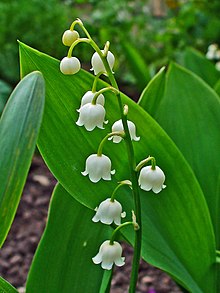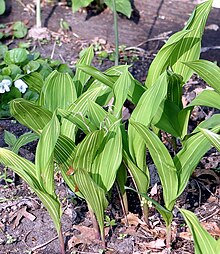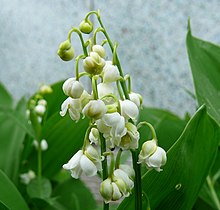Lily of the valley
From Wikipedia, the free encyclopedia
For other uses, see Lily of the valley (disambiguation).
| Lily of the valley | |
|---|---|
 |
|
| Scientific classification |
|
| Kingdom: | Plantae |
| Clade: | Angiosperms |
| Clade: | Monocots |
| Order: | Asparagales |
| Family: | Asparagaceae |
| Subfamily: | Nolinoideae |
| Genus: | Convallaria |
| Species: | C. majalis |
| Binomial name | |
| Convallaria majalis L. |
|
It is possibly the only species in the genus Convallaria (or one of two or three, if C. keiskei and C. transcaucasica are recognised as separate species). In the APG III system, the genus is placed in the family Asparagaceae, subfamily Nolinoideae (formerly the family Ruscaceae[2]). It was formerly placed in its own family Convallariaceae, and, like many lilioid monocots, before that in the lily family Liliaceae.
Contents
Description
C. majalis is a herbaceous perennial plant that forms extensive colonies by spreading underground stems called rhizomes. New upright shoots are formed at the ends of stolons in summer,[3] these upright dormant stems are often called pips.[4] These grow in the spring into new leafy shoots that still remain connected to the other shoots under ground, often forming extensive colonies. The stems grow to 15–30 cm tall, with one or two leaves 10–25 cm long, flowering stems have two leaves and a raceme of 5–15 flowers on the stem apex.The flowers have six white tepals (rarely pink), fused at the base to form a bell-shape, 5–10 mm diameter, and sweetly scented; flowering is in late spring, in mild winters in the Northern Hemisphere it is in early March. The fruit is a small orange-red berry 5–7 mm diameter that contains a few large whitish to brownish colored seeds that dry to a clear translucent round bead 1–3 mm wide. Plants are self-sterile, and colonies consisting of a single clone do not set seed.[5]
Distribution
C. majalis is a native of Europe, where it largely avoids the Mediterranean and Atlantic margins.[1] An eastern variety, C. majalis var. manschurica occurs in Japan and parts of eastern Asia. A limited native population of C. majalis var. montana occurs in Eastern USA .[6] There is, however, some debate as to the native status of the American variety.[7]Ecology
C. majalis is a plant of partial shade, and mesophile type that prefers warm summers. It likes soils that are silty or sandy and acid to moderate basic.[citation needed] It is an Euroasiatic and suboceanic species that lives in mountains up to 1.500 m altitude.[8]C. majalis is used as a food plant by the larvae of some Lepidoptera species including the grey chi. Adults and larvae of the leaf beetle Lilioceris merdigera are also able to tolerate the cardenolides and thus feed on the leaves.[citation needed]
Taxonomy
There are three varieties that have sometimes been separated out as distinct species or subspecies by some botanists.[9]Garden use

Variegated cultivar early in spring
Various kinds and cultivars are grown, including those with double flowers, rose-colored flowers, variegated foliage and ones that grow larger than the typical species.[10]
- C. majalis 'Albostriata' has white-striped leaves
- C. majalis 'Green Tapestry', 'Haldon Grange', 'Hardwick Hall', 'Hofheim', 'Marcel', 'Variegata' and 'Vic Pawlowski's Gold' are other variegated cultivars[10]
- C. majalis 'Berlin Giant' and C. majalis 'Géant de Fortin' (syn. 'Fortin's Giant') are larger-growing cultivars[10]
- C. majalis 'Flore Pleno' has double flowers.[10]
- C. majalis 'Rosea' sometimes found under the name C. majalis var. rosea, has pink flowers.[10]
Chemistry
All parts of the plant are highly poisonous, including the red berries which may be attractive to children.[13] If ingested—even in small amounts—the plant can cause abdominal pain, vomiting, and a reduced heart rate.[14]Roughly 38 different cardiac glycosides (cardenolides) have been found in the plant, some among others:
|
The odor of lily of the valley, specifically the ligand bourgeonal, attracts mammal sperm.[16] The 2003 discovery of this phenomenon prompted research into odor reception,[17] but a 2012 study demonstrated instead that at high concentrations, bourgeonal imitated the role of progesterone in stimulating sperm to swim (chemotaxis), a process unrelated to odor reception.[18]
Legend and tradition
Christian legend
The flower is also known as Our Lady's tears or Mary's tears from Christian legends that it sprang from the weeping of the Virgin Mary during the crucifixion of Jesus. Other etiologies have its coming into being from Eve's tears after she was driven with Adam from the Garden of Eden[19] or from the blood shed by Saint Leonard of Noblac during his battles with a dragon.[citation needed]The name "lily of the valley" is used in some English translations of the Bible in Song of Songs 2:1, but the Hebrew phrase "shoshannat-ha-amaqim" in the original text (literally "lily of the valleys") does not refer to this plant. It is possible, though, that the biblical phrase may have had something to do with the origin or development of the modern plant-name.
It is a symbol of humility in religious painting. Lily of the valley is considered the sign of Christ's second coming. The power of men to envision a better world was also attributed to the lily of the valley.[citation needed]
Other names and legends
Other names include May lily, May bells, and muguet (French). In Bulgarian and Macedonian it is called момина сълза /momina.səlza/ and момина солза respectively, meaning "lass's tear".Its scientific name, majalis or maialis, means "of or belonging to May", and old astrological books place the plant under the dominion of Mercury, since Maia, the daughter of Atlas, was the mother of Mercury or Hermes.[citation needed]
In the "language of flowers", the lily of the valley signifies the return of happiness.[20] Legend tells of the affection of a lily of the valley for a nightingale that did not come back to the woods until the flower bloomed in May.[citation needed]
Use in weddings
Lily of the valley is a popular flower for weddings,[20] although it can be very expensive.[21] Lily of the valley was featured in the bridal bouquet at the wedding of Prince William and Catherine Middleton.[21][22] Lily of the valley was also the flower chosen by Princess Grace Kelly to be featured in her bridal bouquet.Symbolic uses
| This section does not cite any references or sources. (January 2010) |
Lily of the valley was the floral emblem of Yugoslavia and it also became the national flower of Finland in 1967.
In popular culture
In Season 1 Episode 3 "The Way Out" of the TV series Outlander, two boys fall ill after mistaking lily of the valley for edible wood garlic in the ruins of a monastery. Series protagonist Claire Beauchamp Randall, with her 20th century knowledge of botany and medicine, correctly identifies it and successfully treats the poison. Although she notes that lily of the valley is not native to the Scottish setting, her companion Jamie Fraser confirms her theory that the monks were originally from Prussia (Germany). In the award winning TV seres 'Breaking Bad' Walter White poisons a young boy named Brock using lily of the valley.Gallery
-
1 May, by Franz Xaver Winterhalter









Tidak ada komentar:
Posting Komentar